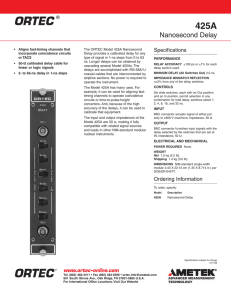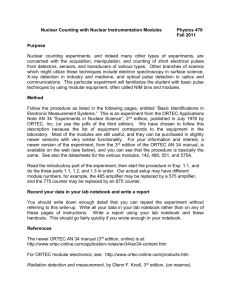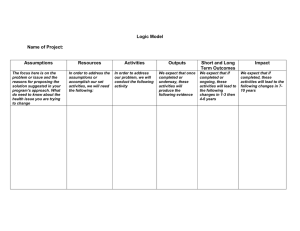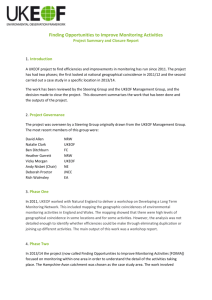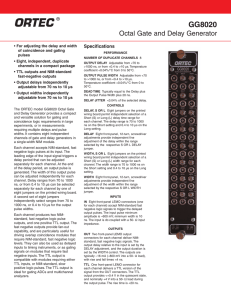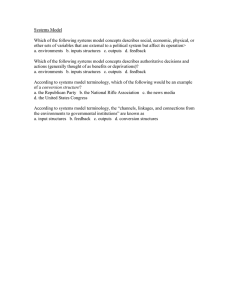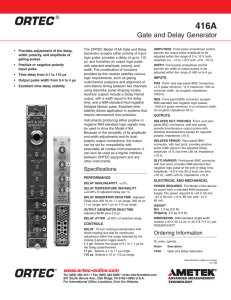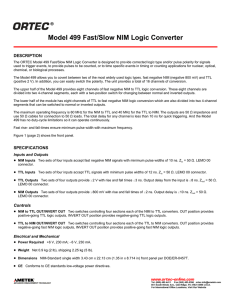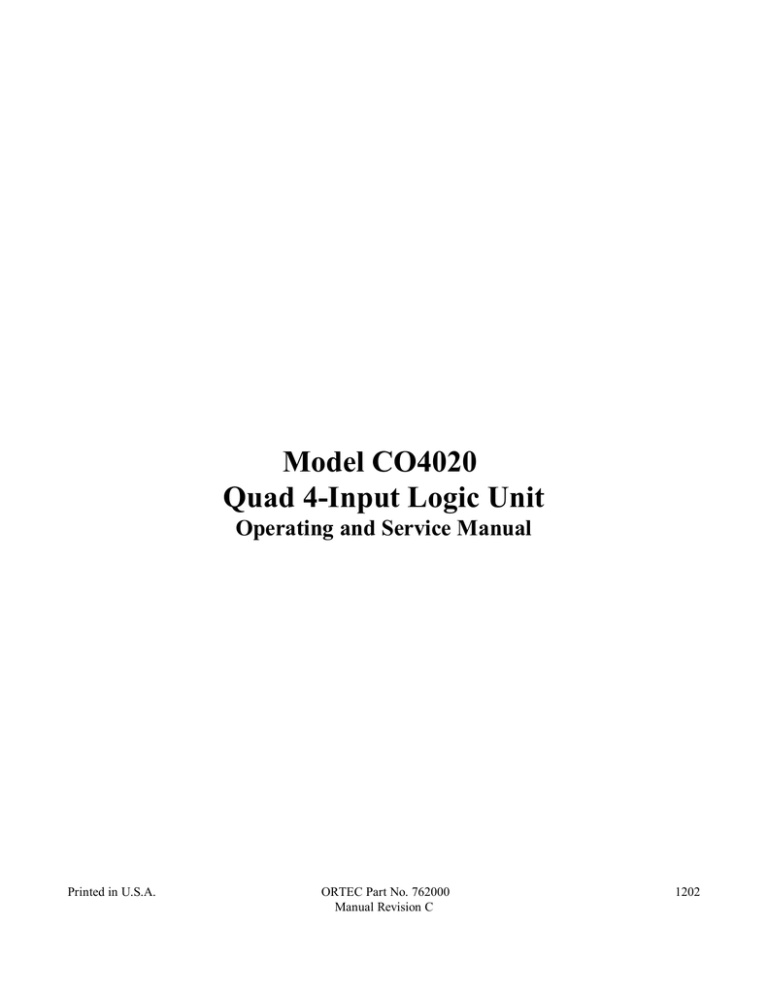
Model CO4020
Quad 4-Input Logic Unit
Operating and Service Manual
Printed in U.S.A.
ORTEC Part No. 762000
Manual Revision C
1202
Advanced Measurement Technology, Inc.
a/k/a/ ORTEC®, a subsidiary of AMETEK®, Inc.
WARRANTY
ORTEC* warrants that the items will be delivered free from defects in material or workmanship. ORTEC makes no
other warranties, express or implied, and specifically NO WARRANTY OF MERCHANTABILITY OR FITNESS
FOR A PARTICULAR PURPOSE.
ORTEC’s exclusive liability is limited to repairing or replacing at ORTEC’s option, items found by ORTEC to be
defective in workmanship or materials within one year from the date of delivery. ORTEC’s liability on any claim of
any kind, including negligence, loss, or damages arising out of, connected with, or from the performance or breach
thereof, or from the manufacture, sale, delivery, resale, repair, or use of any item or services covered by this agreement
or purchase order, shall in no case exceed the price allocable to the item or service furnished or any part thereof that
gives rise to the claim. In the event ORTEC fails to manufacture or deliver items called for in this agreement or
purchase order, ORTEC’s exclusive liability and buyer’s exclusive remedy shall be release of the buyer from the
obligation to pay the purchase price. In no event shall ORTEC be liable for special or consequential damages.
Quality Control
Before being approved for shipment, each ORTEC instrument must pass a stringent set of quality control tests designed
to expose any flaws in materials or workmanship. Permanent records of these tests are maintained for use in warranty
repair and as a source of statistical information for design improvements.
Repair Service
If it becomes necessary to return this instrument for repair, it is essential that Customer Services be contacted in
advance of its return so that a Return Authorization Number can be assigned to the unit. Also, ORTEC must be
informed, either in writing, by telephone [(865) 482-4411] or by facsimile transmission [(865) 483-2133], of the nature
of the fault of the instrument being returned and of the model, serial, and revision ("Rev" on rear panel) numbers.
Failure to do so may cause unnecessary delays in getting the unit repaired. The ORTEC standard procedure requires
that instruments returned for repair pass the same quality control tests that are used for new-production instruments.
Instruments that are returned should be packed so that they will withstand normal transit handling and must be shipped
PREPAID via Air Parcel Post or United Parcel Service to the designated ORTEC repair center. The address label and
the package should include the Return Authorization Number assigned. Instruments being returned that are damaged
in transit due to inadequate packing will be repaired at the sender's expense, and it will be the sender's responsibility
to make claim with the shipper. Instruments not in warranty should follow the same procedure and ORTEC will provide
a quotation.
Damage in Transit
Shipments should be examined immediately upon receipt for evidence of external or concealed damage. The carrier
making delivery should be notified immediately of any such damage, since the carrier is normally liable for damage in
shipment. Packing materials, waybills, and other such documentation should be preserved in order to establish claims.
After such notification to the carrier, please notify ORTEC of the circumstances so that assistance can be provided in
making damage claims and in providing replacement equipment, if necessary.
Copyright © 2002, Advanced Measurement Technology, Inc. All rights reserved.
*ORTEC® is a registered trademark of Advanced Measurement Technology, Inc. All other trademarks used herein are
the property of their respective owners.
TABLE OF CONTENTS
1. DESCRIPTION . . . . . . . . . . . . . . . . . . . . . . . . . . . . . . . . . . . . . . . . . . . . . . . . . . . . . . . . . . . . . . . . . . . . . . . 1
2. SPECIFICATIONS . . . . . . . . . . . . . . . . . . . . . . . . . . . . . . . . . . . . . . . . . . . . . . . . . . . . . . . . . . . . . . . . . . . .
2.1. Performance . . . . . . . . . . . . . . . . . . . . . . . . . . . . . . . . . . . . . . . . . . . . . . . . . . . . . . . . . . . . . . . . . . . .
2.2. Controls and Indicators . . . . . . . . . . . . . . . . . . . . . . . . . . . . . . . . . . . . . . . . . . . . . . . . . . . . . . . . . . . . .
2.3. Inputs . . . . . . . . . . . . . . . . . . . . . . . . . . . . . . . . . . . . . . . . . . . . . . . . . . . . . . . . . . . . . . . . . . . . . . . . . .
2.4. Outputs . . . . . . . . . . . . . . . . . . . . . . . . . . . . . . . . . . . . . . . . . . . . . . . . . . . . . . . . . . . . . . . . . . . . . . . .
2.5. Electrical and Mechanical . . . . . . . . . . . . . . . . . . . . . . . . . . . . . . . . . . . . . . . . . . . . . . . . . . . . . . . . . . .
2
2
2
2
2
3
3. INSTALLATION . . . . . . . . . . . . . . . . . . . . . . . . . . . . . . . . . . . . . . . . . . . . . . . . . . . . . . . . . . . . . . . . . . . . . . 3
4. OPERATING INSTRUCTIONS . . . . . . . . . . . . . . . . . . . . . . . . . . . . . . . . . . . . . . . . . . . . . . . . . . . . . . . . . . 3
4.1. Coincidence Mode ("AND" Function) . . . . . . . . . . . . . . . . . . . . . . . . . . . . . . . . . . . . . . . . . . . . . . . . . . 3
4.2. "OR" Function . . . . . . . . . . . . . . . . . . . . . . . . . . . . . . . . . . . . . . . . . . . . . . . . . . . . . . . . . . . . . . . . . . . 3
iii
iv
1. DESCRIPTION
The ORTEC Model CO4020 Quad 4-Input Logic Unit
has the flexibility to satisfy the logic requirements of
most coincidence experiments without additional logic
modules. The logic functions it can perform are:
coincidence (AND), anti-coincidence (veto), fan-in
(OR), fan-out, fast negative NIM-to-TTL conversion,
and pulse lengthening. The Model CO4020 contains
four identical, independent channels of 4-input logic in
a single-width NIM module.
Each of the four inputs (A, B, C, and D) accepts NIM
fast negative logic pulses. Front-panel, three-position
slide switches select the logic requirements separately
for each input. The various combinations of logic
functions that can be implemented are illustrated in
Fig. 1 and in the specifications for the control
switches.
The X output is a NIM fast negative logic pulse whose
width is determined by the width and overlap of the
active input pulses. The complement of the X output
is available at the X output. The updating Y outputs
can be set to trigger on either the leading edge or the
trailing edge of the X output pulse. The width of the Y
outputs can be adjusted from 40 ns to 40 s in two
selectable ranges. Two of the Y outputs provide NIM
fast negative logic pulses. The third Y output delivers
a positive TTL logic pulse that is suitable for gating
ADCs and multichannel analyzers. Front-panel LEDs
indicate which channel is generating an output.
:
1
2. SPECIFICATIONS
- - - -
-
The Model CO4020 incorporates four separate
channels with identical functions. The specifications
apply to each of the four channels unless stated
otherwise.
Setting the switches to the A,, B,, C,, D,, and G positions
provides the AND (coincidence) function at the X
output.
2.1. Performance
Changing the G switch to G implements the commongate veto (anticoincidence).
-
NUMBER OF IDENTICAL CHANNELS 4.
See Fig. 1 to determine other possible logic
combinations.
MAXIMUM COUNT RATE
-
X and X Outputs 100 MHz.
Y Outputs 1/(1.1 × width).
Trigger Switch for Y Outputs (9 or 8) Allows either
the negative transition (9) or the positive transition (8)
of the X output to trigger the constant-width Y outputs.
MINIMUM PULSE OVERLAP 3 ns.
Y Output Width Range Switch
(1!40 s) or S (40!1200 ns).
:
PROPAGATION DELAY
Input to X, X <8 ns.
Input to Y (Neg) <13 ns.
Input to Y (Pos) <20 ns.
2.3. Inputs
DEAD TIME OF Y OUTPUTS 110% of width setting.
2.2. Controls and Indicators
WIDTH ADJUST (W)
Front-panel screwdriver
adjustment allows width adjustment of Y outputs. Two
ranges can be selected by the front-panel slide switch:
S (40!1200 ns) or L(1!40
:s).
LED INDICATOR Front-panel, red LED lights when
output has been activated.
CONTROL SWITCHES Front-panel, 7- by 3-position
slide switch selects logic function definition, gate
operation, Y output trigger point, and Y output width
adjustment range as follows:
-
-
-
Input Logic Switches (A/OFF/A,, B/OFF/B,, C/OFF/C,,
D/OFF/D,, and G/OFF/G)) As defined in Fig. 1, these
switches select variations of the following basic logic
functions. In the OFF position, the state of that input
is ignored. With switches set to the A, B, C, D, and G
positions, the module performs the OR function at the
X output.
2
Sets either to L
A, B, C, AND D INPUTS
Front-panel LEMO
connectors accept negative fast-NIM logic signals.
Minimum Amplitude !600 mV.
Minimum Width 3 ns.
Input Impedance 50 .
S
GATE INPUT (G)
Front-panel LEMO connector
accepts negative Fast-NIM logic signals. The GATE
input is delivered to all four sections.
Minimum Amplitude !600 mV.
Minimum Width 3 ns.
Input Impedance 50 .
S
2.4. Outputs
-
X AND XOUTPUTS Front-panel LEMO connectors
provide the noninverted (X) and the inverted (X)) result
of the logic satisfied by the input signals. Logic
requirements are set by the front-panel slide switches
A/OFF/A , B/OFF/B ,C/OFF/C , D/OFF/D , and
G/OFF/G. X and X are Fast-NIM logic signals.
Amplitude !20 mA.
Rise Time <4 ns.
Output Width
Determined by duration of input
signals and logic selection.
Y OUTPUTS (
AND
) Front-panel LEMO
connectors provide two updating Fast-NIM logic
outputs (
) and one updating positive TTL logic
output (
) per channel. Output width of all three Y
outputs is set by WIDTH adjustment. Y outputs are
triggered by either the negative transition (9) or
positive transition (8) of the X overlap output as
selected by the front-panel slide switch.
2.5. Electrical and Mechanical
POWER REQUIRED The Model CO4020 derives its
power from a standard NIM bin and power supply. The
required power is +6 V, 200 mA; !6 V, 1000 mA.
WEIGHT
Net 1.3 kg (2.3 lb).
Shipping 2.2 kg (4.8 lb).
3. INSTALLATION
After carefully unpacking the Model CO4020,
thoroughly inspect it for evidence of damage in
shipment. If it has been damaged, refer to the
Warranty section for further instructions.
The Model CO4020 operates on power from a NIM
Bin/ Power Supply such as the ORTEC 4001/4002E.
Always turn off the power to the power supply
before inserting or removing the module. After all
modules have been installed in the Bin, check the dc
voltage levels from the power supply to ensure that no
overload exists.
The Bin and Power Supply is designed for relay rack
mounting. If the equipment is rack mounted, be sure
that adequate ventilation is provided to prevent any
localized heating of components used in the Model
CO4020. The temperature should not exceed 50°C.
4. OPERATING INSTRUCTIONS
The ORTEC Model CO4020 is a Quad 4-Input Logic
that can be used for coincidence, anticoincidence,
fanout, and to convert from a NIM-standard fast
negative logic signal to a positive TTL signal. The four
channels are identical, and the logic functions for each
channel can be independently selected by the
programming switches provided on the front panel in
the form of a 7-section, 3-position, miniature slide
switch. See Fig. 1 for logic function details.
4.1. Coincidence Mode ("AND" Function)
For coincidence mode operation, the slide switches
corresponding to the inputs that must be in
coincidence must be placed to the "overlined" position
- - - (i.e., A ,B,, C,, D,, or G), and the overlap output signal
taken from the X output LEMO. Switches for unused
inputs must be placed in the "OFF" position. If an
anticoincidence condition is required for an input,
place the switch for that particular input to the
position which is not overlined (i.e., A, B, C, D, or G).
For example, if an output is desired when a signal is
present on inputs A and B and C, and no signal on D,
- - -
the switches must be set to A , B,, C,, and D. All outputs
can be gated by a NIM-standard fast negative logic
signal applied to the common "Gate" input. The
effects of the Gate input can be independently set for
each channel by selecting the anti-coincidence, OFF,
or coincidence position for the G/OFF/G switch. The
output signal must be taken from the X output if a
NIM-standard fast negative signal is needed. If any
switch is set to the "overlined" position, the output
becomes the "AND" logic function of the inputs, and
the X output must be used. When placed in the OFF
position, switches representing the inputs disable the
respective inputs so that they have no effect on the
output signal.
4.2. "OR" Function
When an "OR" function is needed, the switches
representing the active inputs must be placed in the
non-overlined position (A, B, C, D, and G) or to the
OFF position if not used. The output signal must be
taken from the "X" output LEMO.
3
4.3. Outputs
In addition to the overlap outputs (X), there are three
outputs (Y) for each channel. Two are NIM-standard
fast negative outputs (
), and one is a positive TTL
output (
). The width of the "Y" output pulse is
independently adjustable for each channel. The
outputs may be triggered on the leading or trailing
edge of the "X" output. The active trigger edge is
selected by the
/OFF/ slide switch. Since the
polarity of the "X" output changes depending on the
mode selected for the logic, the polarity of the leading
and trailing trigger will also change. When operating
4
in the coincidence (AND) mode, the polarity of the
leading edge will be positive, but when operating in
the OR mode, the polarity of the leading edge will
become negative. The "OFF" position is equivalent to
the positive going edge.
The width of the "Y" outputs is adjustable by a frontpanel potentiometer (W) in two ranges selected by the
L/OFF/S slide switch. In the "S" position the width is
adjustable from 40 to 1000 ns. In the "L" position the
width is adjustable from 1 to 40 s. The "OFF"
position is equivalent to the "S" range.
:
BIN/MODULE CONNECTOR PIN ASSIGNMENTS
FOR STANDARD NUCLEAR INSTRUMENT
MODULES PER DOE/ER-0457T
Pin
Function
Pin
Function
1
+3 volts
23
Reserved
2
-3 volts
24
Reserved
3
Spare Bus
25
Reserved
4
Reserved Bus
26
Spare
5
Coaxial
27
Spare
6
Coaxial
28*
+24 volts
7
Coaxial
29*
-24 volts
8
200 volts dc
30
Spare Bus
9
Spare
31
Spare
10*
+6 volts
32
Spare
11*
-6 volts
33*
117 volts ac (Hot)
12
Reserved Bus
34*
Power Return Ground
13
Spare
35
Reset (Scaler)
14
Spare
36
Gate
15
Reserved
37
Reset (Auxiliary)
16*
+12 volts
38
Coaxial
17*
-12 volts
39
Coaxial
18
Spare Bus
40
Coaxial
19
Reserved Bus
41*
117 volts ac (Neut.)
20
Spare
42*
High Quality Ground
21
Spare
G
Ground Guide Pin
22
Reserved
Pins marked (*) are installed and wired in ORTEC’s 4001A and 4001C Modular System Bins.
5
6

